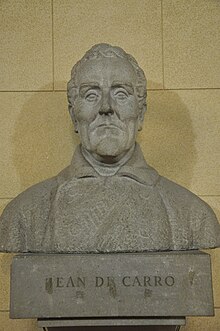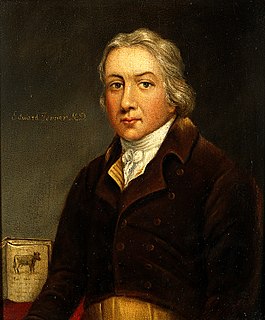
A vaccine is a biological preparation that provides active acquired immunity to a particular disease. A vaccine typically contains an agent that resembles a disease-causing microorganism and is often made from weakened or killed forms of the microbe, its toxins, or one of its surface proteins. The agent stimulates the body's immune system to recognize the agent as a threat, destroy it, and to further recognize and destroy any of the microorganisms associated with that agent that it may encounter in the future. Vaccines can be prophylactic, or therapeutic.
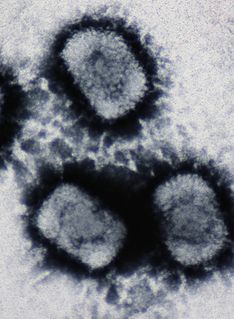
Cowpox is an infectious disease caused by the cowpox virus. The virus, part of the genus Orthopoxvirus, is closely related to the vaccinia virus. The virus is zoonotic, meaning that it is transferable between species, such as from animal to human. The transferral of the disease was first observed in dairymaids who touched the udders of infected cows and consequently developed the signature pustules on their hands. Cowpox is more commonly found in animals other than bovines, such as rodents. Cowpox is similar to, but much milder than, the highly contagious and often deadly smallpox disease. Its close resemblance to the mild form of smallpox and the observation that dairy farmers were immune from smallpox inspired the first smallpox vaccine, created and administered by English physician Edward Jenner.
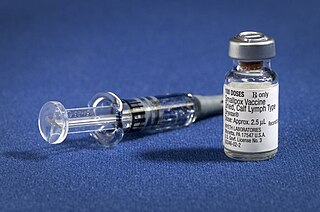
Smallpox vaccine, the first successful vaccine to be developed, was introduced by Edward Jenner in 1796. He followed up his observation that milkmaids who had previously caught cowpox did not later catch smallpox by showing that inoculated cowpox protected against inoculated smallpox.

Vaccinia virus is a large, complex, enveloped virus belonging to the poxvirus family. It has a linear, double-stranded DNA genome approximately 190 kbp in length, and which encodes approximately 250 genes. The dimensions of the virion are roughly 360 × 270 × 250 nm, with a mass of approximately 5–10 fg.
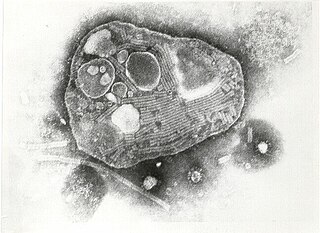
Rinderpest was an infectious viral disease of cattle, domestic buffalo, and many other species of even-toed ungulates, including buffaloes, large antelope and deer, giraffes, wildebeests, and warthogs. The disease was characterized by fever, oral erosions, diarrhea, lymphoid necrosis, and high mortality. Death rates during outbreaks were usually extremely high, approaching 100% in immunologically naïve populations. Rinderpest was mainly transmitted by direct contact and by drinking contaminated water, although it could also be transmitted by air. After a global eradication campaign since the mid-1900s, the last confirmed case of rinderpest was diagnosed in 2001.

Eczema vaccinatum is a rare severe adverse reaction to smallpox vaccination.
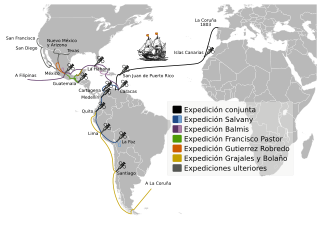
The Balmis Expedition (1803–1806) was a three-year mission to Spanish America and Asia led by Dr. Francisco Javier de Balmis with the aim of vaccinating millions against smallpox. Vaccination, a much safer way to prevent smallpox than older methods such as inoculation, had been introduced by the English physician Edward Jenner in 1798.

James Phipps was the first person given the cowpox vaccine by Edward Jenner. Jenner knew of a local belief that dairy workers who had contracted a relatively mild infection called cowpox were immune to smallpox.
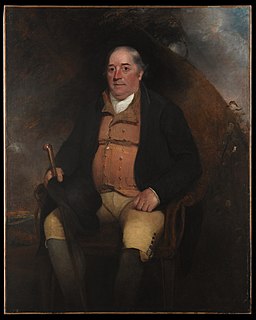
Benjamin Jesty was a farmer at Yetminster in Dorset, England, notable for his early experiment in inducing immunity against smallpox using cowpox.
Artificial induction of immunity is the artificial induction of immunity to specific diseases – making people immune to disease by means other than waiting for them to catch the disease. The purpose is to reduce the risk of death and suffering.

Smallpox was an infectious disease caused by one of two virus variants, Variola major and Variola minor. The last naturally occurring case was diagnosed in October 1977 and the World Health Organization (WHO) certified the global eradication of the disease in 1980. The risk of death following contracting the disease was about 30%, with higher rates among babies. Often those who survived had extensive scarring of their skin and some were left blind.
In 1767, the 11-year-old composer Wolfgang Amadeus Mozart was struck by smallpox. Like all smallpox victims, he was at serious risk of dying, but he survived the disease. This article discusses smallpox as it existed in Mozart's time, the decision taken in 1764 by Mozart's father Leopold not to inoculate his children against the disease, the course of Mozart's illness, and the aftermath.
Variolation or inoculation was the method first used to immunize an individual against smallpox (Variola) with material taken from a patient or a recently variolated individual in the hope that a mild, but protective infection would result. The procedure was most commonly carried out by inserting/rubbing powdered smallpox scabs or fluid from pustules into superficial scratches made in the skin. The patient would develop pustules identical to those caused by naturally occurring smallpox, usually producing a less severe disease than naturally acquired smallpox. Eventually, after about two to four weeks, these symptoms would subside, indicating successful recovery and immunity. The method was first used in China and the Middle East before it was introduced into England and North America in the 1720s in the face of some opposition. The method is no longer used today. It was replaced by smallpox vaccine, a safer alternative. This in turn led to the development of the many vaccines now available against other diseases.
Dr John Fewster (1738–1824) was a surgeon and apothecary in Thornbury, Gloucestershire. Fewster, a friend and professional colleague of Edward Jenner, played an important role in the discovery of the smallpox vaccine. In 1768 Fewster realized that prior infection with cowpox rendered a person immune to smallpox.

The history of smallpox in Mexico spans approximately 500 years of prevalence from the arrival of the Spanish to the official eradication in the country in 1951. It was brought to Mexico by those in Spanish ships, then spread to the center of Mexico, where it became a significant factor in the fall of Tenochtitlan. During the colonial period, there were major epidemic outbreaks which led to the implementation of sanitary and preventive policy. The introduction of smallpox inoculation in New Spain by Franciso Javier Balmis and the work of Dr Ignacio Bartolache reduced the mortality and morbidity of the disease.
The terms inoculation, vaccination, and immunization are often used synonymously to refer to artificial induction of immunity against various infectious diseases. However, there are some important historical and current differences. In English medicine, inoculation referred only to the practice of variolation until the very early 1800s. When Edward Jenner introduced smallpox vaccine in 1798, this was initially called cowpox inoculation or vaccine inoculation. Soon, to avoid confusion, smallpox inoculation continued to be referred to as variolation and cowpox inoculation was referred to as vaccination. Then, in 1891, Louis Pasteur proposed that the terms vaccine and vaccination should be extended to include the new protective procedures being developed. Immunization refers to the use of all vaccines but also extends to the use of antitoxin, which contains preformed antibody such as to diphtheria or tetanus exotoxins. Inoculation is now more or less synonymous in nontechnical usage with injection and the like, and questions along the lines of "Have you had your flu injection/vaccination/inoculation/immunization?" should not cause confusion. The focus is on what is being given and why, not the literal meaning of the technique used.
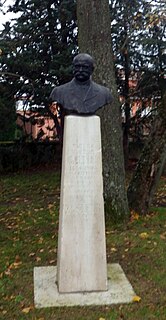
Pierre-Victor or Pierre Victor Galtier was a veterinarian and professor at the National Veterinary School of Lyon, specialising in pathology of infectious diseases, health surveillance and commercial and medical legislation. He developed a rabies vaccine which had some experimental success in laboratory animals.

Louis Jean Odier was a Genevan and then Swiss physician, medical campaigner and advisor; he was also a translator and publisher of medical texts - particularly from the English language. He was a major figure in medicine in 18th-century Europe because of his promotion of vaccination against smallpox and more broadly his lobbying for medical funds and usage of data from historical medical records, relating them to probability in life expectancy and subsequent advice for economic planning.
